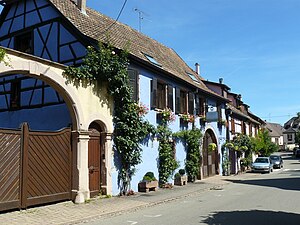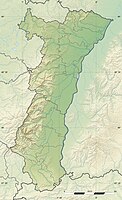 | ||
| Beblenheim | ||
| department | Haut-Rhin | |
|---|---|---|
| Residents | 940 (2018) | |
| height | 221 | |
| other value for height on Wikidata: 180 m, 274 m | ||
| Tourist info | 33 (0)3 89 73 23 23 http://www.ribeauville-riquewihr.com | |
| no tourist info on Wikidata: | ||
| location | ||
| ||
Beblenheim is a city in FrenchAlsace and member of the association of Pays de Ribeauvillé and Riquewihr. The city is on the Alsatian wine route.
background
Beblenheim has a long history: The area was already settled in prehistoric and Gallo-Roman times, as shown by pottery shards. Since the Middle Ages, the fortunes of the place have been with those of the feudal estate of just 1 km to the west Riquewihr connected to which the place was subordinate. Like all of Alsace, the place has been a pawn of nations throughout history. In 1635, during the Thirty Years' War, the place was besieged and plundered by the Lorraine people, the inhabitants were mistreated and taken hostage and the houses were destroyed. Although the war ended in 1648, the place still showed a picture of desolation 20 years later, the place was uninhabited for seven years. In 1945 the place finally became French.
coat of arms
.svg/200px-Blason_de_la_ville_de_Beblenheim_(68).svg.png)
Blazon:
- D'azur à l'agneau pascal d'argent, portant une hampe croisetée d'or en barre de laquelle pend une bannière aussi d'argent chargée d'une croix de gueules.
- ("A silver Easter lamb on blue, carrying a golden flagpole with a cross on which an equally silver flag with an [Alsatian] cross hangs.")
getting there
By plane
The nearest airports, also for tourism, are
- Colmar-Houssen (10 km)
- Strasbourg-Entzheim (63 km)
- Basel-Mulhouse (74 km)
- Nancy-Essey (130 km)
By car
The journey takes place by car
- out Colmar about the D 10 and D 1bis, because of the through town (Ingersheim, Bennwihr, Mittelwihr) the slower but more interesting route, 14 km
- out Colmar about the N 83 to Ostheim, then the Route de Ostheim, 13 km (faster route)
- from the north via the N 83 to Ostheim, then the Route de Ostheim
- from inland (Sainte-Marie-aux-Mines) about the D 416 and D 11, 24 km.
- The next Rhine crossings to Germany are at Breisach (34 km) and Marckolsheim (27 km)
By train
The nearest train station with a TGV stop is in Colmar.
By bus
A 106 bus connects the town with Colmar and Ribeauvillé every 3 hours
mobility

The place is completely surrounded by vineyards and is proud of its Grand Cru locations of the "Sonnenglanz". It only extends a few hundred meters in any direction. However, the main streets in the town are not pedestrian zones. There are also no larger gradients.
Tourist Attractions

- 1 Sandstone monolith - on the forecourt of the church commemorates Chrétien Oberlin (1831-1916), the mayor of the town between 1870 and 1902 and the most important pioneer of Alsatian viticulture. He founded the Viticulture Institute in Colmar and, as a brilliant ampelographer, developed a method of guiding the vines along a wire, which is used worldwide today.
- 2 Église St-Sébastien - The Protestant church was built between 1864 and 1866 as a replacement for a church from the time of Louis XIV that had become a sultaneum. Behind the church, nine tombstones of wealthy citizens from the 15th to 18th centuries adorn a wall.
- 3 Maison Pfister - The house of the historian Christian Pfister (1857-1933), where he experienced his childhood. During this time he was shaped by Jean Macé, became a university lecturer at the Ècole Normale and from 1904 at the Sorbonne. After the First World War he became dean of the literary faculty of the University of Strasbourg and in 1927 rector of the Strasbourg Academy before retiring to this house at the age of 74 in 1931, where he died two years later.
- 4 Église St-Martin - The Catholic Church was built from 1864-1866 on a former cemetery. With the construction of the Protestant church at the same time, the time of the Simultaneum came to an end.
- 5 Mairie - The town hall was built between 1838 and 1840. Pfister was born here. Jean Macé's book collection is on the first floor of the house.
- In the 6 Rue Scheurer-Kestner The cooper and Wagner symbols as well as the initials of the homeowners can be admired on the half-timbered houses.
- 7 Fontaine Saint-Nicolas - The slender fountain is a listed building and is made of yellow sandstone in a Gothic style. Adorned with floral decorations, battlements and depictions of St. Anthony, Nicholas and John (unfortunately disfigured during the French Revolution), it is a particularly beautiful example of the fountains in the local wine villages.
- The 8 House 4 rue des Raisins is impressive House 4 and was built in 1569. A symbol of fertility and luck can be seen on the lintel of the porch, a so-called "swastika". The half-timbered structure of the wooden balcony is designed in the form of" curular chairs ". The wrought-iron shield with the brewer's logo, a star, is younger.
- in the 9 Building 5 rue des Chevaliers from 1673 the tithe is said to have been stored in the cellar. There is also a richly carved decorative strip on the porch with a cooper's mark.
- 10 26 Rue Jean Macé from 1791 - The completely brick mansion bears a winemaker's mark with the initials MG and MV. An old well further to the right, on the corner of rue des Vosges, is a relic of the numerous water points that supplied the former village.
- 11 37 rue Jean Macé from 1623 The house boasts carvings on the corner posts. The inscription for Mathias Vogel, a noble lieutenant from Schoppenwihr, on the lintel cannot be seen from the street.
- The 12 Miscarriage opposite house no.37 and next to house no.33 follows the path of a creek bed, the water of which used to supply the village with water. Follow the path in the direction of rue Stutz and come across a small half-timbered house that probably served as a powder magazine for the villagers.
- 13 Rue Stutz - In 1863, Mrs. Stutz bequeathed her property to the community on condition that it be used for social purposes. The rue Stutz forms the eastern border of the old village.
- 14 7 rue de la Grande Cave The street of "the great cellar" got its name from this house for good reason. The spacious basement rooms of 228 square meters served the Beblenheimers as a shelter during the last world war. The house was built in the 19th century with the stones of the castle Cell Mountain built in 1926 by the owner of the restaurant L'Agneau Blanc (opposite the evangelical church) this house from a winemaker to accommodate his wine cellar and to allow the Munster cheese to mature, which is still done there today.
- 15 Maison Oberlin - House number 25 was that of Chrétien Oberlin, who had it built in 1866. He had the small house on the left built for his servants.
- 16 15 rue de Hoen - House 15 with its striking gable wall facing the street was also built according to Chrétien's plans. The winegrower's house from 1901 with its white painted sandstone window frames.
- 17 14 rue de Hoen - The property opposite the aforementioned is now home to a wine cooperative. This 15th century castle, formerly used as a Dinghof, was owned by the Hoen de Dillenbourg family from 1605 to 1938 and was then sold to a wine merchant, who in 1952 transferred it to the local winegrowers' cooperative. What remains of the castle is a residential building and a raised defensive tower with windows, which is at the rear of the building. It is also worth mentioning: On the brick ground floor: the marking of a stonemason on his workpiece to fix his wages on the window to the right of the door; the year 1461 in Roman numerals; a partially damaged coat of arms on the building's teeth; on the back of the building a field snake loopholes.
- 18 Le Petit-Château - The "little castle" was a boarding house for young girls founded in the 1840s. Jean Macé also taught here from 1852 to 1872 before he "fled" to Monthiers because he did not want to take on German citizenship. His ashes were transferred to Beblenheim in 1946 and buried under his memorial.
- 19 Monument Macé - The Jean Macé monument at the western entrance to the town is made of black marble and contains bronze sculptures by the artist A. David. The central medallion bears the bust of Macé, on the left you can see Macé, surrounded by his pupils in the Petit Château, on the right Macé hands over the signatures of the petitioners for a free, non-denominational and mandatory school system to the National Assembly on June 19, 1871 in Versailles. The titles of Macé's most important works are also engraved.
activities
- From mid-July to mid-September, a winemaker leads the Grands Crus wine trail through the vineyards. Then there is a cellar tour with wine tasting.
- In summer there are visits related to the life of Macé.
- The tourist office has a guide for walks along the Grands Crus wine trail.
shop
Everyday goods are available in a small proxy market, everything else, except wine, of course, is available in the larger neighboring towns.
kitchen
In addition to the restaurants listed below, there are also a large number of Winstubswhich offer small, regional dishes in addition to wine.
- 1 Auberge à l'Agneau Blanc, 3 rue de Hoen, 68980 Beblenheim. Tel.: 33 (0)3 89 47 91 92, Fax: 33 (0)3 89 47 93 28, Email: [email protected]. Completely renovated restaurant with exposed beams. Seasonal menu, children's menu. Patio in the courtyard with barbecue. Specialties: lamb fillet smoked in thyme juice, pikeperch fillet with Riesling, fried foie gras.Open: Open all year round, closed on Wednesdays, lunchtime: 11:45 am to 1:45 pm, in the evening: 6:30 pm to 9:00 pm.Price: Prices: à la carte: max. 25 €, menus up to 64 €.Accepted payment methods: Payment methods: EC and credit cards, checks, meal vouchers, holiday vouchers, cash payments, restaurant tickets.
- 2 Restaurant au Bouc Bleu, 2 rue du 5 décembre, 68980 Beblenheim. Tel.: 33 (0)3 89 47 88 21. Open: Open: Friday to Tuesday, Wednesday and Thursday closed, also on Sunday evenings in winter. Telephone reservations recommended.
nightlife
accommodation
- 1 Chambres La Bergerie, 8 rue de la Grande Cave, 68980 Beblenheim. Tel.: 33 (0)3 89 49 01 33, Fax: 33 (0)3 89 47 94 80, Email: [email protected]. Family hotel, summer garden with grill equipment. Special offers during the low season. Homemade jam. Bicycles are available to customers.Open: all year round.Price: single room max. 60 €, double room 60 € to 70 €, 3-room 4-room max. 100 €, breakfast buffet 8 €.Accepted payment methods: EC and credit cards, checks, diner's club, cash.
Work
security
health
Practical advice
trips
The place is an ideal starting point to the other very beautiful villages of the municipality, to the Vosges and to Colmar.
literature
Web links
- http://www.beblenheim.fr/ - Official website of Beblenheim













